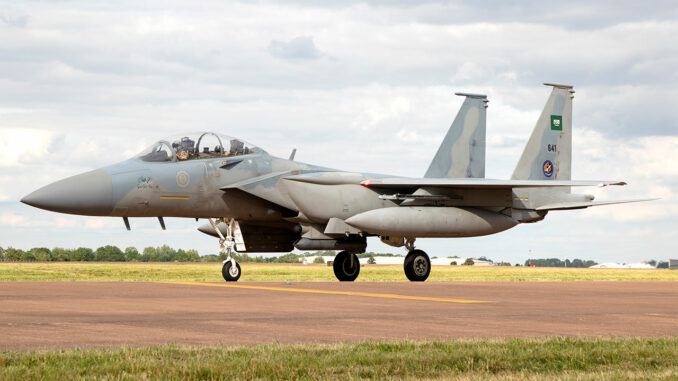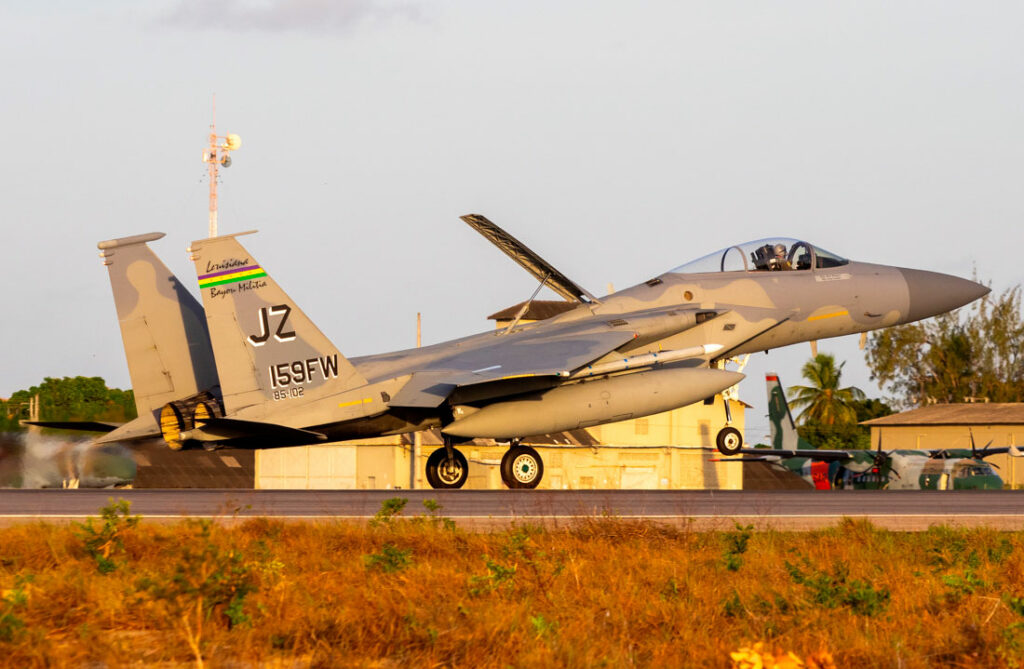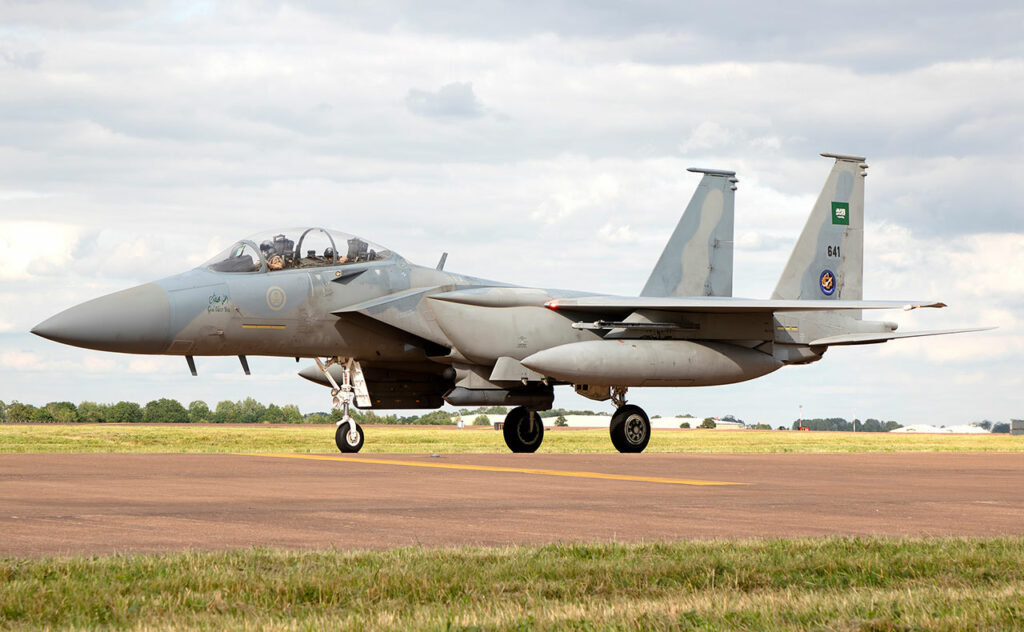
There is much debate about the superiority of the F-15 as a fighter and combat aircraft. Its history, performance, variants and missions are examined here.
The F-15 is one of the world’s best-known fighter jets. It was designed by McDonnell Douglas (now part of Boeing) in the late 1960s. It made its first flight in July 1972. This fighter was designed for air superiority, and distinguished itself by a combination of engine power, maneuverability and advanced electronics. Its distinctive design, with its large lifting surfaces and twin tail fins, gave it outstanding performance from the moment it entered service in 1976. It is used by several air forces, including those of the USA, Israel, Japan and Saudi Arabia. Its average price, depending on version, varies between 60 and 75 million euros per unit, placing it in the upper range of equivalent-generation multi-role combat aircraft.
Its operational history is studded with air victories. Some figures point to over 100 victories in air-to-air combat, with no losses attributed to the enemy in these particular engagements. It should be noted, however, that these figures may vary depending on the source and the conflict concerned. Over the years, the F-15 has evolved through several versions. Each has been adapted to a variety of missions, from pure air superiority to ground attack.
The F-15, in its various forms, can be considered the best fighter of all time.
Background to the F-15
In the 1960s, the US Air Force wanted a fighter capable of outrunning any potential long-term threat. The experiences of the Vietnam War had highlighted the urgent need for a fighter aircraft with strong long-range and close-air combat capabilities. The specification called for high performance, modern radar and the ability to carry a variety of weapons.
The YF-15 prototype carried out its first tests in the early 1970s. It exceeded Mach 2.5, with a top speed of around 2,660 km/h at high altitude. Its climb speed and agility were superior to those of many competitors of the same era. After a series of evaluations, the US Air Force approved series production. The aircraft quickly became operational with the F-15A version, then the F-15B for two-seat training.
Later, the more mature F-15C brought structural improvements and increased internal fuel capacity. The 1980s and 1990s confirmed the fighter’s place in major theaters of operation. Its outstanding success in the Middle East, in various conflicts, reinforced its reputation.

Technical specifications
The F-15 is approximately 19.4 meters long, with a wingspan of 13 meters. Its empty weight is close to 12,700 kg, while its maximum take-off weight can exceed 30,000 kg, depending on weapons and fuel configuration.
It is powered by two Pratt & Whitney F100 turbojet engines, each delivering up to 129 kN of thrust with afterburner on the initial versions. More recent versions, such as the F-15E, benefit from more powerful variants of the F100 or F110 engines, sometimes delivering over 130 kN each.
Its range can exceed 3,800 km with external tanks, making it well suited to long-range interception missions. Its radar, originally an AN/APG-63, has benefited from numerous upgrades, including the introduction of active antenna radars (AESA) on more recent versions, such as the modernized F-15C or the F-15EX. This enables early detection and simultaneous tracking of multiple targets.
The aircraft can carry a wide range of air-to-air (AIM-7 Sparrow, AIM-9 Sidewinder, AIM-120 AMRAAM, etc.) and air-to-ground (guided bombs, cruise missiles, etc.) weapons, depending on the mission.
Performance and missions
The F-15 is capable of reaching altitudes of over 65,000 ft (about 20,000 m), with a climb capability superior to that of many aircraft of its generation. It can engage long-range targets with radar-guided missiles, while remaining formidable in rotary combat thanks to its high thrust-to-weight ratio.
Its structure has been designed to withstand high load factors. Its agile maneuvering gives it an edge in close combat. However, its range and payload also enable it to strike ground targets, notably in the F-15E Strike Eagle version, introduced in the late 1980s.
The Strike Eagle was developed for deep attack, with an expanded multi-role role. It served in numerous conflicts, such as the first Gulf War in 1991, where it carried out targeted strikes, while remaining capable of air-to-air engagements. The operational success of these versions has reinforced confidence in the F-15’s airframe, considered robust enough to withstand successive upgrades.
Variants and evolutions
In addition to the first A/B and C/D versions, the F-15 has undergone a number of specific variants. The most striking of these is the E (Strike Eagle) series, which features radar-monitored terrain navigation, a two-seat cockpit and avionics optimized for ground attack. This version can carry up to 10,400 kg of payload, ranging from guided bombs to missiles.
The F-15I, operated by Israel, is based on the Strike Eagle with domestic equipment. The F-15K, used by South Korea, features comparable evolutions, adapted to local needs. The F-15SA and F-15QA, intended for Saudi Arabia and Qatar, incorporate recent innovations, including digital flight controls and an upgraded AESA radar.
Finally, the F-15EX has been launched for the US Air Force. It features a superior weapons load, advanced radar and state-of-the-art electronic warfare systems. Its potential service life exceeds 20,000 flight hours, a remarkable achievement for a fighter derived from a 1970s concept.
Operational advantages
The F-15 has demonstrated fairly high operational availability. Maintenance remains demanding, due to the complexity of its engines and electronic systems, but user air forces emphasize its reliability. Its maintenance has been facilitated by a long logistics chain, supported by Boeing and several international subcontractors.
Pilots appreciate its visibility from the cockpit, its stability and its precise flight control system. Its power enables it to climb quickly, pursue high-altitude targets or escape from unfavorable combat conditions. In a context of air superiority, the F-15 can prove formidable.
Tactically, it is often deployed to intercept border intrusions or to provide air cover for sensitive areas. Its long range enables it to operate without refueling over significant distances, making it an ideal choice for extended air defense missions.
Operational missions
Over the years, the F-15 has been used for a wide range of missions, from air superiority to ground interdiction. Its use in several theaters of operation has enabled us to measure its effectiveness in a variety of contexts. Here’s a detailed overview of its main military actions.
Beginnings and first interceptions
- First deployments: After entering service in the mid-1970s, the US Air Force began positioning F-15A and F-15B aircraft in Europe and Japan for deterrence missions. These aircraft were intended for surveillance of NATO airspace, particularly against potential intrusions. During this period, actual interceptions remained limited, but the aircraft was already demonstrating a rapid reaction capability thanks to its AN/APG-63 radar.
- Israel Air Force (IAF): The IAF took delivery of its first F-15s in 1976. Between the late 1970s and early 1980s, Israeli F-15s were involved in intercepting Syrian MiGs. During the 1982 Lebanon War (also known as Operation Peace in Galilee), some reports put the number of enemy aircraft shot down by Israeli F-15s and F-16s at around 40, with a significant proportion attributed to F-15s. Exact figures vary from source to source, but it’s widely accepted that the aircraft played a major role in Israel’s air superiority at the time.
Gulf War (1991)
- Desert Storm air phase : The F-15C/D and F-15E (Strike Eagle) were used extensively. The F-15Cs carried out the air superiority mission, accounting for a large proportion of the coalition’s air victories. Of the 41 air victories claimed by the US Air Force during this conflict, 34 were attributed to the F-15C. The effectiveness of the radar and the range of the AIM-7 Sparrow, AIM-9 Sidewinder and AIM-120 AMRAAM missiles enabled engagements at significant distances.
- F-15E Strike Eagle: This two-seat version flew air-to-ground missions. It took part in over 2,200 sorties, according to official figures. F-15Es targeted Iraqi strategic infrastructures, artillery sites and airfields. They frequently carried laser-guided bombs (GBU-10, GBU-12) and inertial-guided bombs (GBU-15). The Strike Eagle’s Conformal Fuel Tanks (CFT) gave it long range, enabling it to strike distant targets.
Balkans and European operations (1990s)
- Balkans operations: Between 1993 and 1995, the international coalition conducted several air campaigns in the former Yugoslavia (Deny Flight, Deliberate Force). US Air Force F-15Cs contributed to the no-fly zone, providing protection for ground attack aircraft (A-10s, F-16s, etc.). Official NATO statistics indicate that F-15s took part in permanent aerial surveillance, carrying out pre-emptive intercepts of Serbian fighters. In 1994, an F-15C shot down several Serbian helicopters in a single salvo, underlining the ability to engage multiple targets in a matter of seconds with radar-guided missiles.
- Reinforcement for NATO: In the 1990s, F-15s based in Europe regularly took part in joint exercises, reinforcing deterrence against potential threats. They flew an average of several hundred hours a year, and maintained a satisfactory operational availability rate (often in excess of 70%, according to the USAF).
Post-2001 operations (Afghanistan, Iraq)
- Afghanistan (Operation Enduring Freedom) : After 2001, the F-15E was deployed for close support and interdiction missions. The F-15C remained assigned to air cover, even though the threat from enemy aircraft remained low. The Strike Eagle flew several hundred sorties a month, using laser- or GPS-guided bombs (GBU-31 JDAM). According to official US Air Force figures, thousands of air strikes were carried out by all aircraft, a significant proportion of them by F-15Es.
- Iraq (Operation Iraqi Freedom, 2003) : F-15Es played an important role in the early hours of the air campaign. Their ability to carry a wide range of munitions (up to 10,400 kg) enabled them to strike several strategic targets simultaneously. In the first few weeks, the F-15Es flew more than 1,700 sorties, according to various military sources. As for the F-15Cs, they remained on alert for air superiority, but the Iraqi air force presented no significant opposition in the air.
Other operators and recent engagements
- Saudi Arabia: F-15SAs, derivatives of the F-15E, have been engaged in the conflict in Yemen since 2015. They carried out strikes against rebel positions, using air-to-ground missiles and guided bombs. Precise operational balances are not widely available, but it is known that several major strikes involved F-15SAs.
- Japan : The F-15J and F-15DJ, produced under license by Mitsubishi, form the backbone of Japanese air defense. Every year, they carry out hundreds of interceptions, notably of foreign bombers or reconnaissance aircraft in the Japanese air identification zone. In 2016, Japan reported some 851 interceptions (all aircraft combined), a significant proportion of which were carried out by F-15Js. This air policing mission remains crucial for the Japanese Air Force.
- Israel (recent developments) : The IAF continues to employ the F-15C/D (“Baz”) and the F-15I (“Ra’am”). The F-15I, the local equivalent of the Strike Eagle, is often used for long-range missions. According to some estimates, the IAF maintains a high availability rate for its F-15s, in the order of 75-80%, in order to be able to carry out precise strikes if necessary.
Review and key figures
- Air superiority: The F-15C is credited with over 100 air-to-air victories in various conflicts (USA, Israel, etc.) without a confirmed loss in air-to-air combat being officially recognized.
- Air-to-ground missions : The F-15E and its derivatives have proven their tactical worth, carrying out several thousand sorties in the Gulf, Afghanistan and Iraq wars.
- Availability rate: On average, the various user air forces report an availability rate often in excess of 70%, despite the complexity of the avionics.
- Cost and upgrades : Modernizations (AESA radar, countermeasure systems, intelligent weapons) have kept the F-15 at the level required to face evolving threats, with a notable budgetary impact (several billion euros invested since the 1990s).
From the late 1970s to the present day, the F-15 has fulfilled air defense, strategic strike and long-range patrol tasks in a variety of air forces. Its many engagements have given it a substantial operational record, backed up by quantified results. Although each campaign has its own particularities, the F-15, whether C/D or E version, has often been chosen for critical missions, testifying to its reliability and adaptability to a variety of challenges.

Comparison with other fighters
Some consider the F-15 to be a major fighter of the late 20th and early 21st centuries. It is sometimes compared with aircraft such as the Russian Su-27 and its derivatives, or the French Rafale, or the lighter F-16. In terms of sheer maneuverability, more recent fighters such as the F-22 Raptor or Su-35 can rival or even surpass the F-15. However, these aircraft belong to a more advanced generation, equipped with stealth or even more advanced flight controls.
The F-15 is not stealthy. Nevertheless, it remains an imposing and feared fighter, especially when combined with long-range weapons and high-performance radars. Its record of victories helps forge a solid reputation. However, today’s market offers more modern, more discreet multi-role aircraft.
Analysis of the “best fighter of all time” depends on multiple criteria. The F-15 stands out for its longevity, proven combat effectiveness and ability to be modified for new missions. Other aircraft, however, designed for stealth or electronic attack, meet more contemporary needs.
Longevity factors and upgrades
One of the F-15’s strengths is its robust structure. Its large fuselage allows the integration of additional equipment. Successive modernizations have involved the cockpit (digital displays, helmet sights, etc.), avionics, radar and countermeasure systems.
Maintenance costs can be high after several decades of use. Despite this, the US Air Force has ordered the F-15EX to replace some aging F-15Cs. The reasons for this choice are logistical compatibility, established pilot training and the potential to carry heavy weapons.
In a context of budget constraints, some countries are looking for aircraft that are more versatile and less costly to acquire and maintain. The F-15 remains a proven platform, but its purchase price of between 60 and 75 million euros, depending on equipment, may seem high compared with other modern, lighter fighters.
War Wings Daily is an independant magazine.